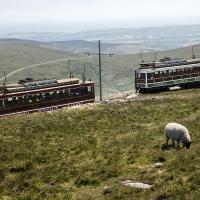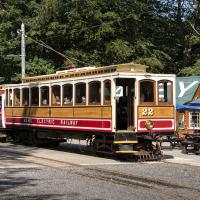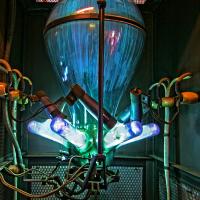The Manx Electric Railway (MER) operates nearly 18 miles of track between Douglas and Ramsey, nowadays with a seasonal summer timetable. The first section between Groudle and Douglas opened in 1893, being extended progressively to Ramsey by 1899. The system is narrow gauge with a 3 foot wide track and still uses original motorised tramcars and trailers which date variously from 1893 onwards making it the oldest such system in the world.
At Laxey, there is the option of transferring to the Snaefell Mountain Railway (SMR) with a 5 mile stretch of track taking one to the summit. The SMR dates from 1895, and amalgamated with the MER in the same year. Somewhat oddly, the SMR is also a narrow gauge system but runs with a 3 foot 6 inch gauge so the units are not interchangeable. There were originally 6 tramcars operating the Snaefell service, numbered 1-6, but Number 3 was a runaway down the mountain in 2016 and its derailment leaves just 5 units currently available. Whilst the bodies are largely as original, due to difficulty in obtaining spare parts, the original motors were replaced in the 1970s with second hand units from German trams which had been taken out of service.
With the age of the system, it will be no surprise that it has a somewhat chequered history a fire at Laxey in 1930 resulted in a significant loss of MER motor units and trailers, whilst there were financial difficulties in 1902 and 1957, the latter resulting in the system being nationalised and nowadays runs as part of the Dept of Infrastructure, together with the Steam Railway.
Both the MER and SMR units run on 550 volt DC power using overhead lines supported on pylons. At first, both the MER and SMR motor units obtained their power using pairs of Hopkinson bow collectors these are still used on the mountain railway due to their reliability whilst the MER units have been converted to use trolley poles, the pole being simply reversed on arrival at the end of each journey. The different processes are obvious in the attached images.
Originally the electricity was generated by the railway's own power stations, using mercury arc rectifiers to convert alternating current to the 550 volt direct current required. The mercury arc rectifier is a fascinating piece of electrical engineering history superseded by solid state thyristors in the 1960s, but an example still exists in Laxey. As seen in Sues image, the large glass bulb is filled with liquid mercury and contains electrodes through which AC current passes, heating the mercury which vaporises and effectively creating a diode, allowing the electricity to pass as direct current.
As noted above, the IOMPS has re-started its weekly meetings, the next being scheduled for Wednesday 12th May when Chris Blyth will be presenting Travels through America. The meeting starts at 7:00pm and all will be given a warm welcome, non-members with a small entry fee. Programme details may be seen on our website www.iomps.com and our Facebook page.
The Society is supported by the Arts Council.
Chris Blyth
CAPTIONS:
IMAGE 01: View from Snaefell summit by Sue Jones
IMAGE 02: MER at Laxey Station by Sue Jones
IMAGE 03: Mercury Arc Rectifier by Sue Jones



